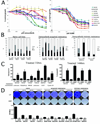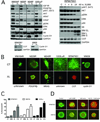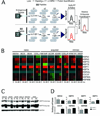The HSP90 inhibitor XL888 overcomes BRAF inhibitor resistance mediated through diverse mechanisms
- PMID: 22351686
- PMCID: PMC3398738
- DOI: 10.1158/1078-0432.CCR-11-2612
The HSP90 inhibitor XL888 overcomes BRAF inhibitor resistance mediated through diverse mechanisms
Abstract
Purpose: The clinical use of BRAF inhibitors is being hampered by the acquisition of drug resistance. This study shows the potential therapeutic use of the HSP90 inhibitor (XL888) in six different models of vemurafenib resistance.
Experimental design: The ability of XL888 to inhibit growth and to induce apoptosis and tumor regression of vemurafenib-resistant melanoma cell lines was shown in vitro and in vivo. A novel mass spectrometry-based pharmacodynamic assay was developed to measure intratumoral HSP70 levels following HSP90 inhibition in melanoma cell lines, xenografts, and melanoma biopsies. Mechanistic studies were carried out to determine the mechanism of XL888-induced apoptosis.
Results: XL888 potently inhibited cell growth, induced apoptosis, and prevented the growth of vemurafenib-resistant melanoma cell lines in 3-dimensional cell culture, long-term colony formation assays, and human melanoma mouse xenografts. The reversal of the resistance phenotype was associated with the degradation of PDGFRβ, COT, IGFR1, CRAF, ARAF, S6, cyclin D1, and AKT, which in turn led to the nuclear accumulation of FOXO3a, an increase in BIM (Bcl-2 interacting mediator of cell death) expression, and the downregulation of Mcl-1. In most resistance models, XL888 treatment increased BIM expression, decreased Mcl-1 expression, and induced apoptosis more effectively than dual mitogen-activated protein-extracellular signal-regulated kinase/phosphoinositide 3-kinase (MEK/PI3K) inhibition.
Conclusions: HSP90 inhibition may be a highly effective strategy at managing the diverse array of resistance mechanisms being reported to BRAF inhibitors and appears to be more effective at restoring BIM expression and downregulating Mcl-1 expression than combined MEK/PI3K inhibitor therapy.
©2012 AACR.
Figures






Comment in
-
Will Hsp90 inhibitors prove effective in BRAF-mutant melanomas?Clin Cancer Res. 2012 May 1;18(9):2420-2. doi: 10.1158/1078-0432.CCR-12-0626. Epub 2012 Mar 22. Clin Cancer Res. 2012. PMID: 22442059
Similar articles
-
Inhibition of Wee1, AKT, and CDK4 underlies the efficacy of the HSP90 inhibitor XL888 in an in vivo model of NRAS-mutant melanoma.Mol Cancer Ther. 2013 Jun;12(6):901-12. doi: 10.1158/1535-7163.MCT-12-1003. Epub 2013 Mar 28. Mol Cancer Ther. 2013. PMID: 23538902 Free PMC article.
-
Evaluating melanoma drug response and therapeutic escape with quantitative proteomics.Mol Cell Proteomics. 2014 Jul;13(7):1844-54. doi: 10.1074/mcp.M113.037424. Epub 2014 Apr 23. Mol Cell Proteomics. 2014. PMID: 24760959 Free PMC article.
-
The Novel ATP-Competitive MEK/Aurora Kinase Inhibitor BI-847325 Overcomes Acquired BRAF Inhibitor Resistance through Suppression of Mcl-1 and MEK Expression.Mol Cancer Ther. 2015 Jun;14(6):1354-64. doi: 10.1158/1535-7163.MCT-14-0832. Epub 2015 Apr 14. Mol Cancer Ther. 2015. PMID: 25873592 Free PMC article.
-
Resistance to Raf inhibition in cancer.Drug Discov Today Technol. 2014 Mar;11:27-32. doi: 10.1016/j.ddtec.2013.12.004. Drug Discov Today Technol. 2014. PMID: 24847650 Free PMC article. Review.
-
Navigating the therapeutic complexity of PI3K pathway inhibition in melanoma.Clin Cancer Res. 2013 Oct 1;19(19):5310-9. doi: 10.1158/1078-0432.CCR-13-0142. Clin Cancer Res. 2013. PMID: 24089444 Free PMC article. Review.
Cited by
-
NRAS mutant melanoma: biological behavior and future strategies for therapeutic management.Oncogene. 2013 Jun 20;32(25):3009-18. doi: 10.1038/onc.2012.453. Epub 2012 Oct 15. Oncogene. 2013. PMID: 23069660 Free PMC article. Review.
-
Heat shock proteins and heat shock factor 1 in carcinogenesis and tumor development: an update.Arch Toxicol. 2013 Jan;87(1):19-48. doi: 10.1007/s00204-012-0918-z. Epub 2012 Aug 11. Arch Toxicol. 2013. PMID: 22885793 Free PMC article. Review.
-
Reactivation of ERK and Akt confers resistance of mutant BRAF colon cancer cells to the HSP90 inhibitor AUY922.Oncotarget. 2016 Aug 2;7(31):49597-49610. doi: 10.18632/oncotarget.10414. Oncotarget. 2016. PMID: 27391062 Free PMC article.
-
Vemurafenib: an evidence-based review of its clinical utility in the treatment of metastatic melanoma.Drug Des Devel Ther. 2014 Jun 16;8:775-87. doi: 10.2147/DDDT.S31143. eCollection 2014. Drug Des Devel Ther. 2014. PMID: 24966667 Free PMC article. Review.
-
Dabrafenib inhibits the growth of BRAF-WT cancers through CDK16 and NEK9 inhibition.Mol Oncol. 2018 Jan;12(1):74-88. doi: 10.1002/1878-0261.12152. Epub 2017 Nov 23. Mol Oncol. 2018. PMID: 29112787 Free PMC article.
References
-
- Smalley KS, Sondak VK. Melanoma--an unlikely poster child for personalized cancer therapy. N Engl J Med. 2010;363:876–878. - PubMed
Publication types
MeSH terms
Substances
Grants and funding
LinkOut - more resources
Full Text Sources
Other Literature Sources
Medical
Research Materials
Miscellaneous

